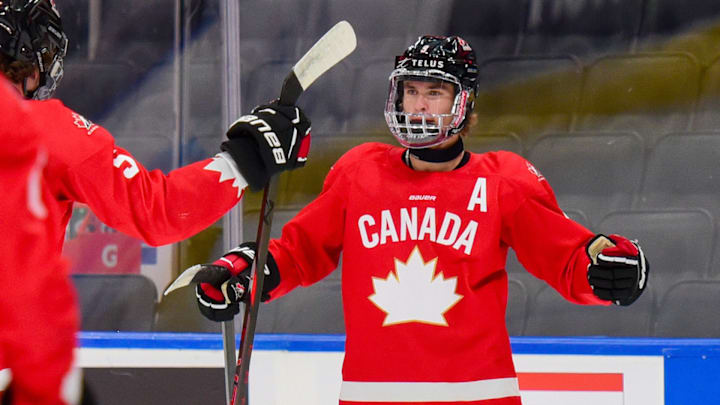One of the NHL's brightest young star prospects is going the NCAA route in his draft-eligible year, as projected first overall pick Gavin McKenna has announced he will be joining the hockey program at Penn State for the 2025-26 season.
The 17-year-old forward's decision sends a definitive message about the NCAA's status as a preferred destination for future NHL talent -- potentially over other major junior leagues across North America.
His commitment coincides with a new rule that allows players to make the transition from major junior leagues to the NCAA beginning with this upcoming season. Previously, those skaters were not allowed to compete due to the NCAA's rules against amateurism.
McKenna has spent parts of the last three seasons playing with the Medicine Hat Tigers of the WHL, one of three junior leagues that comprise the Canadian Hockey League (CHL). There, he tallied an enormous 129 points in just 56 games played in 2024-25, plus another 38 points in 16 playoff games.
The CHL has historically churned out some of the NHL's most elite talent. Connor McDavid played for the OHL's Erie Otters, Sidney Crosby skated with the Rimouski Océanic of the QMJHL, and Joe Sakic was a member of the WHL's Swift Current Broncos, just to highlight a few.
Yet it would appear that, with McKenna's commitment to Penn State, the needle is starting to point more and more in the direction of the NCAA especially now with the aforementioned rule change.
Let's not overlook all of the superstars that are products of college hockey, either. Johnny Gaudreau was one of Boston University's most elite scorers of all time, Cale Makar skated in two seasons for UMass-Amherst, and Connor Hellebuyck backstopped UMass-Lowell for two years. The NCAA has long been a very viable path to the NHL.
But the impact of McKenna's commitment could mark a new shift towards college hockey for the NHL's best prospects.
Please enjoy four and a half minutes of Gavin McKenna highlights after he officially announced his commitment to @PennStateMHKY. 🔥
— NHL (@NHL) July 8, 2025
The projected 2026 first overall pick is already a star.
(🎥: @tigershockey & @TheWHL) pic.twitter.com/m3iQaMAXZu
Will this cause more NHL prospects choose NCAA hockey over major juniors?
The Nittany Lions have been a Division I program since 2013-14, making their first-ever appearance in the Frozen Four tournament this year. But this is more than just a win for Penn State. McKenna choosing to go the NCAA route, and specifically a non-traditional destination over a powerhouse like Michigan State, is a huge boost for college hockey.
It sends a major signal to other prospects that NCAA programs can offer elite development that's comparable to other junior leagues, and it even comes with some added bonuses. ESPN has reported that McKenna recieved a six-figure Name, Image, and Likeness (NIL) offer that allows him to profit off of his personal brand.
There's also the fact that the NCAA offers an older group of players compared to the juniors, where there is an age range of 16 to 20 years. There is something to be said about the level of competitiveness at the college level versus the younger skaters of the CHL.
"I think [college] honestly just makes the jump [to the NHL] easier. Going against older, heavier, stronger guys, I think it really prepares you."Gavin McKenna, to NHL.com
Having the choice to pursue NCAA hockey is going to continue to make a big impact on NHL prospects, and McKenna's noteworthy decision is no doubt going to affect the landscape for developing players.
